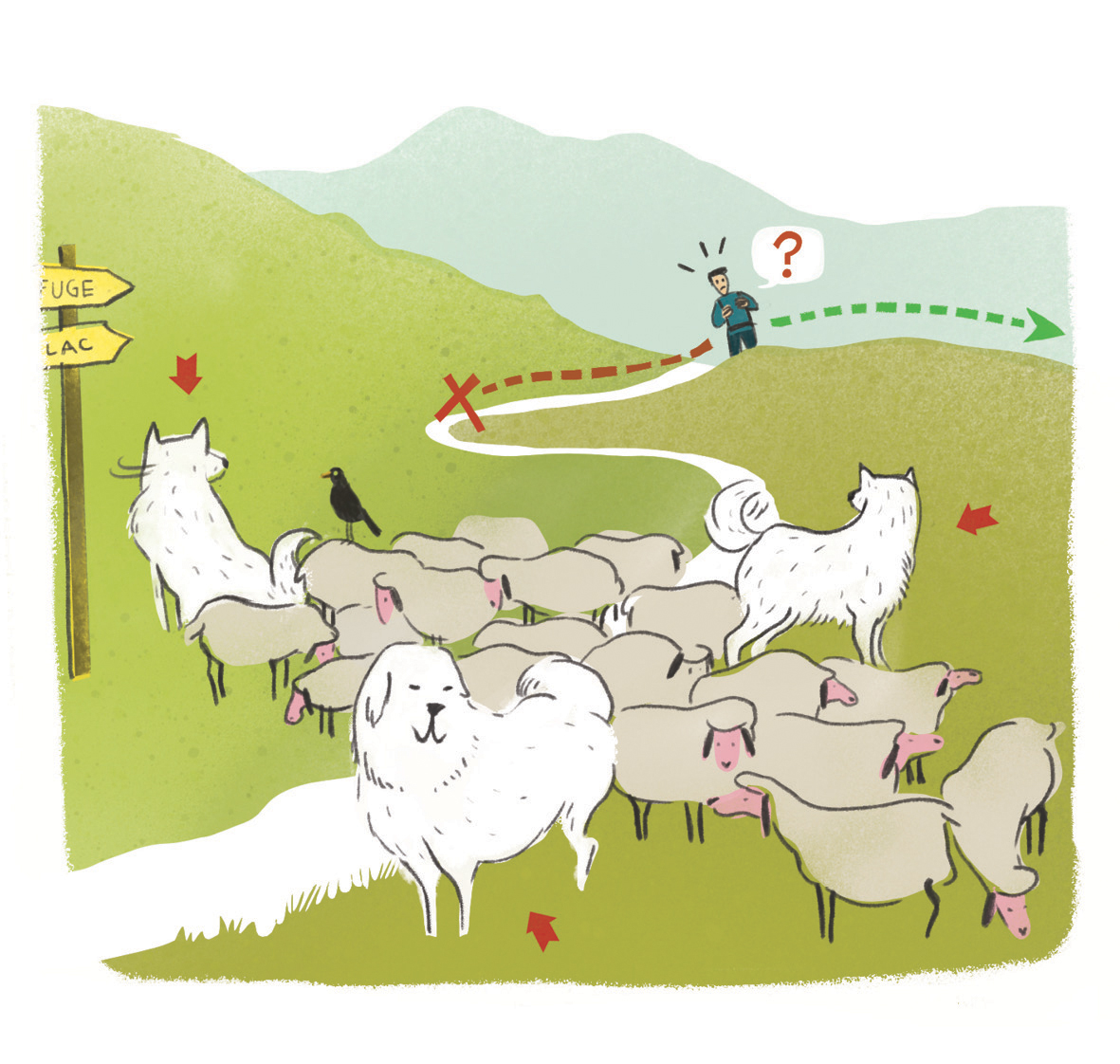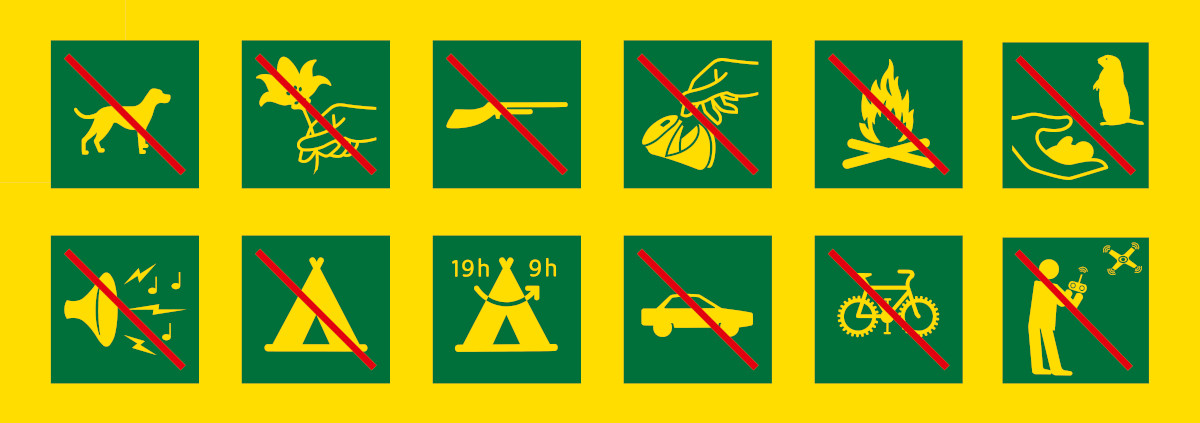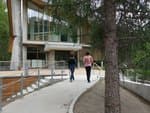Le Pas de Cavale
"Freezing and enclosed, the Fournel valley? Not as much as you would think as even the pig that the shepherd took to the Grand Cabane got sunburnt!"
Jean-Philippe Telmon, warden.
34 points of interest
 Fauna
FaunaSmooth snake
In the first bends of the path, the big slates heat up under the sun. Sometimes, one of them becomes the hideout of a small snake, the smooth snake. Everything about it is soft: its rounded lines, its smooth scales, its round pupils, its pink grey colour. A dark band around its muzzle, passes under the eye and goes round behind the head, forming the crown which gives it its name in French. Discreet and inoffensive, it hunts lizards sunning themselves and who hide at the slightest sound.
 Geology and geography
Geology and geographyThe old slate quarry
Between 1851 and 1953, a slate quarry in the Salce was intermittently exploited. The slate was used for the rooves of houses. Its weight (40 kg au m²) ensured that the wind could not blow it away. The slate, presented an enormous advantage over thatch: in that there was no risk from fire. Blocks were cut in winter and in consequence this activity was complementary to the agricultural work.
 Flora
FloraCommon Juniper
Able to live up to 400 years, this shrub looks hunched over and can even creep along when it has reached its altitudinal limit. Lower down, it adopts a rigid princely position. Its needles are very sharp and are positioned in threes. Its violet fleshy fruit is only carried by the female parts of the plant enabling them to be correctly identified. They are used as aromatics for their digestive properties. The inhabitants of the Briançon vallies chew the berries to protect against « cold snaps » and at Freissinières, the vapour of the juniper is recommended against colds.
 Fauna
FaunaThe short winged small cicada
This small cicada is quite common on the warm dry side of the valley. To see it, it is best to be patient! But it is child’s play to hear its very high sound with a low intensity. It is a buzzing crescendo followed by a brief separated accent: « Tsssssssssss... tsit ». The larva lives for a few years in the ground, then on a hot day it jumps onto a branch to transform itself in to a flying and singing insect to attract males. Sometimes, you can find a discarded exoskeleton under a juniper bush, the envelope left by the larva after moulting.
 Flora
FloraLarge flowered foxglove
This large flower does not go unnoticed with its bunch of yellow corolla. Its name in French ‘digitale’ comes from its similarity to the thimble in which one slips ones finger. In common parlance, its name is « witch’s glove » because it is a highly poisonous plant.
 Flora
FloraThe mountain violet
As a carpet of violet flowers, sometimes yellow, white or mixed, the mountain violet adorns fresh grass with its colours. We call it the spurred violet. In fact its spur is visible on the back of the flower,it is long and only insects with a long tongue like the butterflies can collect pollen from them. Violets and pansies are part of the same family. To tell them apart, you just have to look at the two lateral petals: oriented downwards for violets and upwards for the pansies. The pansy is an optimistic flower!
 Pastoralism
PastoralismThe cabin of the Balme
The cabin of the Balme is situated on the plateau of the same name, a little above the path. This site offers an uninterrupted view of the bottom of the Fournel valley and its steep summits. This cabin, like the one at Salce and the Grande Cabane, is used for the shepherds work. Please respect its tranquility.
 Flora
FloraEast alpine violet fescue
The East alpine violet fescue is an early perennial grass, it grows in tufts and can have up to 50 leaves, which are between 30 to 50 cm long. They thicken and harden with maturity and become increasingly less appetizing for animals grazing late in the season. In this way the East alpine violet fescue spreads, forming large patches in the alpine meadow: called “le queyrellin” On the sunny side of the Fournel valley, agri-environmental measures envisage adapted grazing in order to limit the extension of the East alpine violet fescue in order to preserve the floral diversity of the alpine meadow.
 Fauna
FaunaThe common kestrel
A small, elegant bird of prey with a red back, black wing tip flies away. Above the prairie, it is immobile in the position of the « Holy spirit », The tail fanned out, before diving down to its prey. It is a common kestrel, the most frequently seen falcon. Also called « speckled » because of its speckled feathers, it is easy to observe it above the pastures heated by the sun.
 Geology and geography
Geology and geographySteep sandstone ditches in the Champsaur
On the steep slopes of the summits which border the Fournel valley there are a multitude of folds whose ridges follow a repetitive theme. It is the most visible sign of an intense global shearing of the surface.
 Pastoralism
PastoralismPasture and flocks
A large flock of sheep bringing together several flocks from the community of L'Argentière-la-Bessée grazes in the Fournel valley during the hot weather. The shepherd brings the sheep up during the summer and takes them back down again at the end of the pasture to eat the second crop of Queen of the Alps which have planted their seeds. During the grazing the shepherd, uses three cabins: the one at Salce, the one at Balme and the Grande Cabane.
 Geology and geography
Geology and geographyThe Fournel « boutonnière »
From the Deslioures carpark, you can observe the Fournel running into the canyons of the Balme, carved out in the crystalline base covered wih Champsaur sandstone. There the erosion has slowly, smoothed the sandstone covering, to slash the crystalline rocks over 300 m. It is the Fournel “boutonnière”. On the path, it is easy to see the junction between the crystalline rocks and their sandstone covering separated by a thin intermediary layer of Limestone with a rim form, commonly called the Balme, which gives its name to the pasture and to the cabin.
 Fauna
FaunaYellow billed Chough
A whirl of black birds moves noisily along the edge of the Fournel before landing amongst the juniper bushes. In a joyful rumpus, they come to feed on the blue berries that winter has left them. In the air they make breathtaking, demonstrations of flying in formation like a school of fish in the ocean. .The yellow billed Chough is friendly and will not hesitate to approach hikers in order to peck the crumbs from their picnics.
 Fauna
FaunaRed billed Chough
A flying companion to the yellow billed Chough, the red billed Chough plays in the clouds and breaks the silence with its brief strident cry, which sounds almost metallic .Alerted by the echo coming from the canyon wall, it is joined by its companions stride meticulously on foot across the pasture to extract the grass crickets and small worms. Their legs are as red as their beak and we most often see them in the sky flying in a couple.
 Flora
FloraWhite Asphodel
The White Asphodel is a plant that is big in size, visible from a distance, it appreciates chalky soils. Its white flowers blossom in time along the floral spike situated at the end of a thick stem. . This is why we can observe fruit at the bottom of the spike even though the flowers at the top of the spike are still in bud. Its long narrow leaves are grouped at the base of the stem, they give it it’s common name « the dogs’ leek ».
 Flora
FloraNarrow leaf bur-reed
It is in the calm shallow water of the small lake facing the Grande Cabane that a dense colony, of narrow leaf bur-reed has developed. Its leaves, flat and long, float on the surface of the water while its flowers rise above the surface of the water. Starting off as green balls with spiky points, they blossom into yellow balls, spreading their pollen to the four winds. Formerly harvested, the « water ribbons » were used as ties, fodder or padding.
 Fauna
FaunaThe aspic viper
Taken by surprise whilst basking in the sun, a snake suddenly weaves its way into the grass just in front of the walker's step foot. With its triangular head, vertical pupil, stocky body, short tail and quite a snubbed nose, this is an aspic viper. Instinctively the walker flees. However, the snake has long since disappeared into its hole. Snakebites are extremely rare as the viper only attacks in defence if it is caught or if it is stepped on. It would much rather keeps its venom for small rodents, lizards or sparrows which are swallowed whole, then slowly digested. Fauna
FaunaCommon Rock Thrush
On a crag of rock, orange breast, blue head and white rump, a bird flies away making a melodious, sweet and clear song. The Common Rock Thrush does not only live in the mountains but prefers stones and sunshine above everything else. As soon as it returns from its migration at the end of April, it searches for a place to reproduce and it makes its presence known. Inspite of its bright colours, this bird knows how to be discreet and you will be lucky to observe it on a rock near to the Grande Cabane.
 Architecture
ArchitectureWalker's shelter
Opposite the Grande Cabane, a sign indicates: "GR54 shelter". Indeed, perched on the rocky ledge is a simple, damp, stone shelter that provides a roof for walkers on the GR route in the case of bad weather. It has not yet been restored, and offers little more for the time being. Pastoralism
PastoralismThe Grande Cabane
The point of the hike, the Grande Cabane seems lost in the immensity of the high Fourne valley. This cabin is used by the shepherd. A shelter for hikers is available in the old cabin situated against the rocky escarpment, on the other shore of the torrent. This pasture is part of the network of « Sentinel Pastures », a system that studies the different physical, natural and human parameters in order to understand and anticipate the impact of climate change on the pastures in the Ecrins and the Alpes. Covered with ancient moraines, the terrain is softened, the landscape less harsh. On this lower shelf, the Fournel meanders calmly and you can observe small lakes and wetland .Several indications of the presence of ancient human life have been discovered here by archeologists, the oldest going back to prehistoric times.
 Fauna
FaunaWheatear
At the end of April, on the soil of the pasture, the snow melts progressively. The rocks are used as perches by the Wheatear, who has just returned from its migration. The male appears first: in breeding plumage, he has a grey head and back, a mask like Zorro over the eyes, a white abdomen and dark wings. He is easily recognized in flight by his white rump and the black T shape made by his tail. The female is paler and less contrasted. Often positioned on a jutting rock , they watch their surroundings looking for insects.
 Top
TopThe Pointe des Rougnoux and Pic Félix
The Pointe des Rougnoux (3179 m) is an easily recognizable summit because it is composed of several peaks and is shared between the vallies of Champoléon in Champsaur, Fournel and Freissinières on the Durance side. The Pic Félix Neff (3243 m) has a north slope towards the Fournel valley and its south slope above the hamlet of Dormillouse where the pastor Félix Neff was established in 1823. A real « apostle of the Hautes-Alpes », this pastor from Geneva worked as an evangelist, teacher, agronomist and engineer. At Dormillouse, he preached and improved daily life (he cultivated potatoes, created irrigation channels, and improved the sanitation in the stables).
 Fauna
FaunaAzure butterfly
A summer storm has left a puddle on the footpath. A plethora of small blue butterflies drinks up the precious water. The butterfly got its name from the sky-blue colour on the inside of the male's wings, but this is a vernacular name covering several species. Be they azure, common blue or mountain alcon blue butterflies, all lay their eggs on the eponymous plant on which the caterpillar feeds. After nibbling away at the buds of their favourite plant, some caterpillars will be voluntarily caught by ants and taken to the anthill. Here, they feeds on the ant brood in exchange for a sweet liquid that the ants love. Fauna
FaunaLa libellule a quatre taches
A dragonfly, four wings, a dark spot on the leading edge of each wing: it is a four-spotted dragonfly. The male observes its territory from a promontory amongst the vegetation on the edge of calm water. If a rival should dare to approach, then a nimble airborne joust will ensue. It is in the air that these dragonflies catch the gnats and mosquitoes that they are so fond of and it is also where they mate in quite acrobatic positions. A true high-flyer! Flora
FloraGiant puffball mushroom
Commonplace in the alpine meadows, the round white mushrooms turn brown with maturity and change into bags of spores that are puffed out when touched. Did this give them their French name, which is literally "wolf fart"? Some giant puffball mushrooms can be the size of a football and are particularly visible in the green meadows, whereas others are more unobtrusive. They are all edible while they are young and still firm. Cut them into slices and cook them in a frying pan. Flora
FloraArctic rush
In the wetland of the high Fournel valley, the green stem of rushes points towards the sky in a few patches. No higher than 40 cm, they are straight and hollow. During the summer, the upper third adorns a simple bunch of small delicate brown stars that can only be properly seen from very close up. This rush likes acid marshland, damp moraines or the banks of the alpine streams and is a rare and protected species in both the Rhone-Alpes and Provence-Alpes-Côte d'Azur regions. This species is also a remnant from the glaciation period. Fauna
FaunaMountain Burnet
These black and red butterflies have thick antenna that point forwards and they can often be found on a blade of grass or a flower. Although they are active during the daytime, their morphology classes them as moths. Their peculiarity is that they are able to draw a chemical component resembling cyanide from plants, which they secrete by their mouth or joints when faced with danger. That is enough to keep the predators at bay! To distinguish it from its cousins, look at the five red spots on its wings. The elongated one on the leading edge takes up roughly half the length of the almost transparent background. Flora
FloraIl geum montanum
I grandi fiori, rallegrando le praterie alpine con i loro puntini giallo dorato, fioriscono in estate su un corto stelo e vengono rimpiazzati dopo la fioritura con frutti arrufati, come parrucche rosse scompigliate. Giunto a maturazione, questo frutto secco detto achenio si fa trasportare dal vento o si attacca al pelo di qualche animale. Le foglie, a forma di spatola allungata, molto frastagliate nella parte inferiore, terminano con una grande foglia oblunga e dentellata. Flora
FloraField gentian
This small gentian is very original if compared to others in the family. It does nothing like its more emblematic alpine cousins. They have ramified stems with several flowers and constitute mauve bunches in the subalpine meadow. Each small flower has a crown of four petals, and is adorned with filaments resembling eyelashes. It is simple in shape and in colour, nothing like the strong blue of its cousins. Flora
FloraFairies' thimbles
These plants are used to scree and cracks in the rocks where they grow in small groups. This elegant plant is easy to recognise with its large, fine, violet, bell-shaped flowers that sway at the end of a delicate, short stem. Its beauty and delicateness are a reward to walkers who are not discouraged from climbing up over the rough scree or intermingled blocks in which it thrives. Fauna
FaunaGolden eagle
Undisputed king of the air, it swirls near to the sunlit slopes to gain altitude in search of its prey. The Fournel valley is home to a pair of golden eagles that can often be seen at the hottest hours of the day. Some years, the pair do not even go to the trouble of building a nest to lay an egg, preferring to just fly freely. Then one day, the female will lay two eggs, compensating for their failure to ensure survival of the species. Therefore, two young eagles take flight at the end of the summer, displaying white at the base of their tails and in the form of "rosettes" on their wings. Flora
FloraSpiniest Thistle
In the land of dwarf plants, this one is a giant even if it never grows more than 50 cm tall. In the middle of the scree, pastures and sheep pens or sheltered by a rocky ledge, its numerous leaves, which are full of thorns rise towards the sky. An army of pale yellow bracts that are stiff and sharp protects its yellow flower heads that are tightly packed together. The plant likes to be amongst the animals and benefits from their manure. This is not a mutual attraction however. Flora
FloraAlpine toadflax
Among the grey scree, is a bouquet of small two-toned mauve and orange snapdragons on the end of a creeping stem, which has short, fleshy, bluish leaves. Beneath the summer sun, whilst the leaves make the most of the heat from the stones, the flowers attract bees and bumblebees that come to gather the nectar. In exchange for this sweet liquid, they ensure pollination by foraging flower after flower on the slopes of scree. Fauna
FaunaRock ptarmigan
In the still of dawn, on the rocky ridges of the Pas de la Cavale, a rough, almost metallic squawk resounds. A ball of stone among the shingle, the rock ptarmigan is the champion of camouflage: only its husky cry or its flight gives it away. Originally from the Arctic tundra, this bird was present during the glaciation period then retreated to the mountains where it found the necessary conditions for its survival. It is invisible due to its colour, when filled with air its feathers act as insulation against the bitter cold and the feathers that fully cover its feet act as snowshoes. It is currently one of the most endangered species of the Alps.
Description
From the Deslioures Car Park, at the end of the trail that follows the Fournel stream, take the footpath to the right, which is an alternative itinerary to the GR54 trail (Tour of Oisans). After the first few bends, you will arrive at a plateau from which a trail through the shale leads to La Balme pastoral hut. Follow this trail to the Clausis stream and enter the National Park. Then continue until you reach the Grande Cabane, which is situated above the Fournel glacial cross-cliff.
- From here, the footpath continues up into the valley alongside beautiful wetlands, crossing scree and shale before reaching the pass.
- Three possibilities for the return trip: back the way you came, via the Pré de la Chaumette to get to the Champsaur or by l’Aup Martin pass in order to reach Vallouise.
- Departure : Deslioures Car Park, La Salce, l'Argentière-La-Bessée
- Towns crossed : L'Argentière-la-Bessée
Forecast
Altimetric profile
Recommandations
The car park is a stone's throw away from the Deslioures ecological reserve, which is the largest European site for the Queen of the Alps. This is a protected plant and it is strictly forbidden to pick it. It blossoms from July to August.
 In mountain pastures, protection dogs are there to protect the herds from predators (wolves, etc.).
In mountain pastures, protection dogs are there to protect the herds from predators (wolves, etc.).
When I hike I adapt my behavior by going around the herd and pausing for the dog to identify me.
Find out more about the actions to adopt with the article "Protection dogs: a context and actions to adopt".
Tell us about your meeting by answering this survey.
Information desks
Vallouise Park house
, 05290 Vallouise
Information, documentation, models, exhibitions, screenings, product sales and works of the Park. Guided tours for school, reservation required. The new Park House opened in Vallouise since June 1, and offers visitors an interactive permanent exhibition inviting to explore the area and its heritage. A temporary exhibition space will allow a renewed offer. Finally, the device is completed by an audiovisual room to organize screenings and conferences Free admission. All animations of the Park are free unless otherwise stated.
Transport
Nearest SNCF train station : L'Argentière-les-Ecrins (www.voyages-sncf.com)
L'Argentière-les-Ecrins / La Salce: taxi (Taxi Pellegrin 06 98 88 17 78 / Taxi Billau 06 08 03 45 90)
Access and parking
From the roundabout, with the wagon on it, in l'Argentière-La-Bessée, head towards the Fournel valley. The road climbs up above the village and continues into the Fournel valley. A track then leads up to the Deslioures Car Park (1560 m).
CAUTION: this small road is generally closed in winter 200 m before the hamlet of l'Eychaillon (1250 m).
Parking :
Source

Report a problem or an error
If you have found an error on this page or if you have noticed any problems during your hike, please report them to us here:


